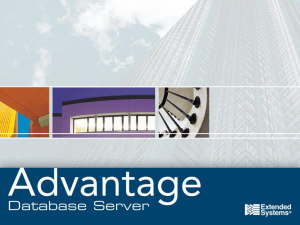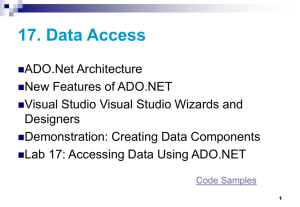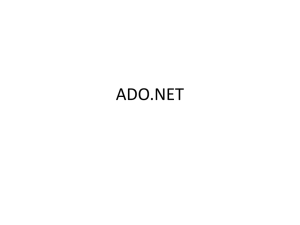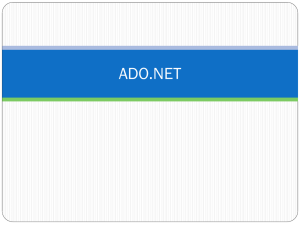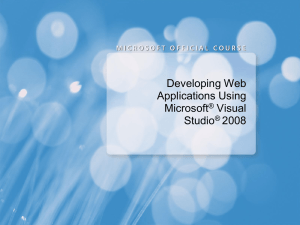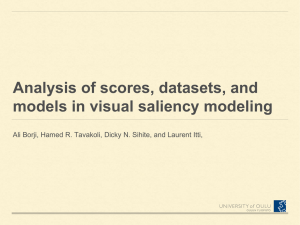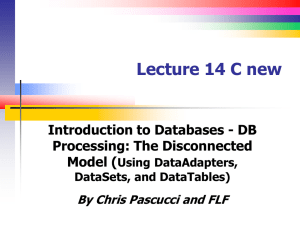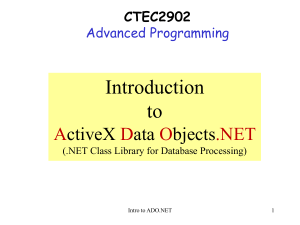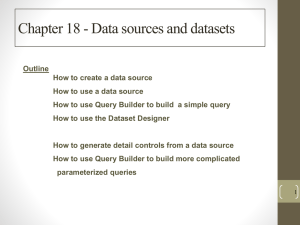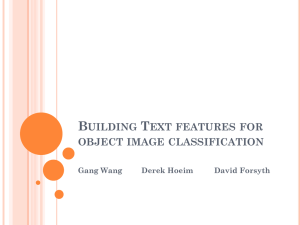What Is ADO.NET?
advertisement
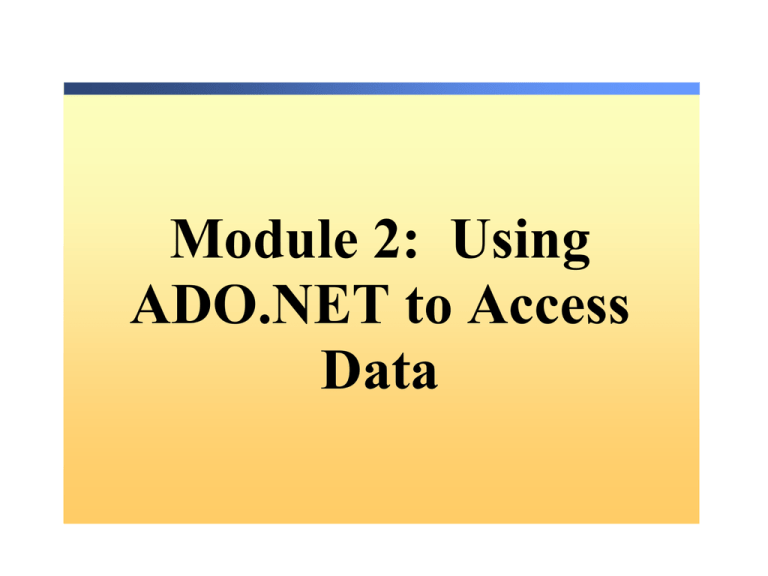
Module 2: Using ADO.NET to Access Data Overview ADO.NET Architecture Creating an Application That Uses ADO.NET to Access Data Changing Database Records Lesson: ADO.NET Architecture What Is ADO.NET? What Is a Connected Environment? What Is a Disconnected Environment? What Is the ADO.NET Object Model? What Is the DataSet Class? What Is the .NET Data Provider? What Is ADO.NET? ADO.NET is a data access technology. It provides: A set of classes, interfaces, structures, and enumerations that manage data access from within the .NET Framework An evolutionary, more flexible successor to ADO A system designed for disconnected environments A programming model with advanced XML support What Is a Connected Environment? A connected environment is one in which users are constantly connected to a data source Advantages: Environment is easier to secure Concurrency is more easily controlled Data is more likely to be current than in other scenarios Disadvantages: Must have a constant network connection Scalability What Is a Disconnected Environment? In a disconnected environment, a subset of data from a central data store can be copied and modified independently, and the changes merged back into the central data store Advantages You can work at any time that is convenient for you, and can connect to a data source at any time to process requests Other users can use the connection A disconnected environment improves the scalability and performance of applications Disadvantages Data is not always up to date Change conflicts can occur and must be resolved What Is the ADO.NET Object Model? DataSet .NET Data Provider Connection Transaction Command DataAdapter SelectCommand InsertCommand Parameters UpdateCommand DataReader DeleteCommand DataTableCollection DataTable DataRowCollection DataColumnCollection ConstraintCollection DataRelationCollection XML Database Multimedia: Using ADO.NET to Access Data What Is the DataSet Class? DataSet Tables Table DataSets consist of one or more tables and relations Columns Loaded from one or more data adapters Column Created as you work Constraints Loaded from XML Loaded from other DataSets Constraint Rows Row Relations Tables contain columns, constraints, and rows All are collections! Relation Object Collection What Is the .NET Data Provider? Database Connection Manages the connection to a database Executes a query command on the database Command Exchanges data between the data set and the database DataAdapter DataReader Provides efficient access to a stream of read-only data Practice: ADO.NET Architecture Matching Practice 10 min Lesson: Creating an Application That Uses ADO.NET to Access Data How to Specify the Database Connection How to Specify the Database Command How to Create the DataAdapter Object How to Create a DataSet Object How to Bind a DataSet to a DataGrid How to Use the Data Wizards in Visual Studio .NET How to Specify the Database Connection Use the Connection object to: Choose the connection type Specify the data source Open the connection to the data source Use the connection string to specify all of the options for your connection to the database, including the account name, database server, and database name string connectionStr = @"Data Source=localhost; Integrated Security=SSPI; Initial Catalog=northwind"; How to Specify the Database Command string commandStr=@"SELECT CustomerName, CompanyName FROM Customers"; Create a string containing SQL statements Remember that Verbatim strings can make this much easier! Examples of SQL statements: SELECT * FROM Customers SELECT CustomerName FROM Customers SELECT * FROM Customers WHERE Country = 'Mexico' How to Create the DataAdapter Object DataSet Data source DataAdapter DataTable Fill Update DataAdapter DataTable Fill Update How to Create a DataSet Object DataSet Use Fill method of DataAdapter Populate programmatically by creating a table structure and filling it Read an XML document or stream into a DataSet Use Merge method to copy the contents of another DataSet object Tables Table Columns Column Constraints Constraint Rows Row Relations Relation Object Collection How to Bind a DataSet to a DataGrid To bind programmatically DataGrid dataGrid1 = new DataGrid(); sqlDataAdapter1.Fill(dataSet1, "Customers"); sqlDataAdapter2.Fill(dataSet1, "Orders"); dataGrid1.DataSource = dataSet1; Demonstration: Using the Data Wizards in Visual Studio .NET In instructor-led demonstration will show you how to use the Data Adapter Configuration Wizard, how to use the Server Explorer, and how to use the Data Form Wizard How to Use the Data Wizards in Visual Studio .NET Practice: Using the Data Adapter Configuration Wizard Guided Practice In this practice you will add a new database record to the Shippers table in the Northwind Traders database You will use the Data Adapter Configuration Wizard in Visual Studio .NET to generate most of the code 10 min Lesson: Changing Database Records How to Access Data in a DataSet Object How to Update a Database in ADO.NET How to Create a Database Record How to Update a Database Record How to Delete a Database Record How to Access Data in a DataSet Object DataRow objects DataTable objects DataColumn objects DataColumn objects How to Update a Database in ADO.NET Client Server DataAdapter DataSet Database Fill Data Update Data DataTable InsertCommand UpdateCommand DeleteCommand How to Create a Database Record Create a new row that matches the table schema DataRow myRow = dataTable.NewRow(); Add the new row to the dataset dataTable.Rows.Add( myRow ); Update the database sqlDataAdapter1.Update( dataSet ); How to Update a Database Record Modify the row containing the record Generate a new dataset containing the changes Check the new dataset for errors Merge the changes back into the original dataset Call the Update method on the data adapter Call the AcceptChanges method on your original dataset How to Delete a Database Record Delete the row from the dataset dataTable.Rows[0].Delete(); Update the database dataAdapter.Update(dataSet); Accept the changes to the dataset dataSet.AcceptChanges(); Practice: Updating a Database Record Guided Practice In this practice, you will create and delete a database record, experimenting with the Update, AcceptChanges and RejectChanges methods 10 min Review ADO.NET Architecture Creating an Application That Uses ADO.NET to Access Data Changing Database Records Lab 7.1: Creating a Data Access Application with ADO.NET Exercise 1: Creating a simple database table viewer Exercise 2: Writing a Simple Database Table Viewer Exercise 3 (if time permits): Creating a simple database viewer 1 hour Lab 7.2 (optional): Creating a Windows Application That Uses ADO.NET Exercise 1: Creating a Windows Application that uses ADO.NET Exercise 2 (if time permits): Writing an ADO.NET Application with Windows Forms 1 hour
